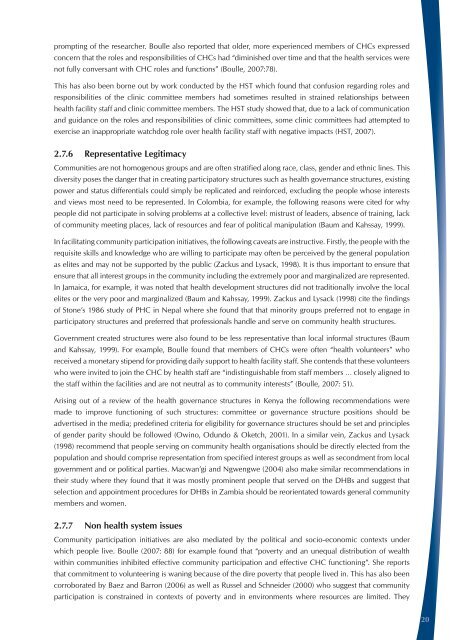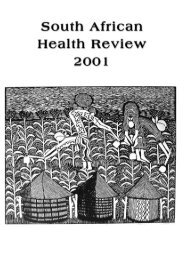The Status of Clinic Committees in Primary Level - Health Systems ...
The Status of Clinic Committees in Primary Level - Health Systems ...
The Status of Clinic Committees in Primary Level - Health Systems ...
You also want an ePaper? Increase the reach of your titles
YUMPU automatically turns print PDFs into web optimized ePapers that Google loves.
prompt<strong>in</strong>g <strong>of</strong> the researcher. Boulle also reported that older, more experienced members <strong>of</strong> CHCs expressed<br />
concern that the roles and responsibilities <strong>of</strong> CHCs had “dim<strong>in</strong>ished over time and that the health services were<br />
not fully conversant with CHC roles and functions” (Boulle, 2007:78).<br />
This has also been borne out by work conducted by the HST which found that confusion regard<strong>in</strong>g roles and<br />
responsibilities <strong>of</strong> the cl<strong>in</strong>ic committee members had sometimes resulted <strong>in</strong> stra<strong>in</strong>ed relationships between<br />
health facility staff and cl<strong>in</strong>ic committee members. <strong>The</strong> HST study showed that, due to a lack <strong>of</strong> communication<br />
and guidance on the roles and responsibilities <strong>of</strong> cl<strong>in</strong>ic committees, some cl<strong>in</strong>ic committees had attempted to<br />
exercise an <strong>in</strong>appropriate watchdog role over health facility staff with negative impacts (HST, 2007).<br />
2.7.6 Representative Legitimacy<br />
Communities are not homogenous groups and are <strong>of</strong>ten stratified along race, class, gender and ethnic l<strong>in</strong>es. This<br />
diversity poses the danger that <strong>in</strong> creat<strong>in</strong>g participatory structures such as health governance structures, exist<strong>in</strong>g<br />
power and status differentials could simply be replicated and re<strong>in</strong>forced, exclud<strong>in</strong>g the people whose <strong>in</strong>terests<br />
and views most need to be represented. In Colombia, for example, the follow<strong>in</strong>g reasons were cited for why<br />
people did not participate <strong>in</strong> solv<strong>in</strong>g problems at a collective level: mistrust <strong>of</strong> leaders, absence <strong>of</strong> tra<strong>in</strong><strong>in</strong>g, lack<br />
<strong>of</strong> community meet<strong>in</strong>g places, lack <strong>of</strong> resources and fear <strong>of</strong> political manipulation (Baum and Kahssay, 1999).<br />
In facilitat<strong>in</strong>g community participation <strong>in</strong>itiatives, the follow<strong>in</strong>g caveats are <strong>in</strong>structive. Firstly, the people with the<br />
requisite skills and knowledge who are will<strong>in</strong>g to participate may <strong>of</strong>ten be perceived by the general population<br />
as elites and may not be supported by the public (Zackus and Lysack, 1998). It is thus important to ensure that<br />
ensure that all <strong>in</strong>terest groups <strong>in</strong> the community <strong>in</strong>clud<strong>in</strong>g the extremely poor and marg<strong>in</strong>alized are represented.<br />
In Jamaica, for example, it was noted that health development structures did not traditionally <strong>in</strong>volve the local<br />
elites or the very poor and marg<strong>in</strong>alized (Baum and Kahssay, 1999). Zackus and Lysack (1998) cite the f<strong>in</strong>d<strong>in</strong>gs<br />
<strong>of</strong> Stone’s 1986 study <strong>of</strong> PHC <strong>in</strong> Nepal where she found that that m<strong>in</strong>ority groups preferred not to engage <strong>in</strong><br />
participatory structures and preferred that pr<strong>of</strong>essionals handle and serve on community health structures.<br />
Government created structures were also found to be less representative than local <strong>in</strong>formal structures (Baum<br />
and Kahssay, 1999). For example, Boulle found that members <strong>of</strong> CHCs were <strong>of</strong>ten “health volunteers” who<br />
received a monetary stipend for provid<strong>in</strong>g daily support to health facility staff. She contends that these volunteers<br />
who were <strong>in</strong>vited to jo<strong>in</strong> the CHC by health staff are “<strong>in</strong>dist<strong>in</strong>guishable from staff members … closely aligned to<br />
the staff with<strong>in</strong> the facilities and are not neutral as to community <strong>in</strong>terests” (Boulle, 2007: 51).<br />
Aris<strong>in</strong>g out <strong>of</strong> a review <strong>of</strong> the health governance structures <strong>in</strong> Kenya the follow<strong>in</strong>g recommendations were<br />
made to improve function<strong>in</strong>g <strong>of</strong> such structures: committee or governance structure positions should be<br />
advertised <strong>in</strong> the media; predef<strong>in</strong>ed criteria for eligibility for governance structures should be set and pr<strong>in</strong>ciples<br />
<strong>of</strong> gender parity should be followed (Ow<strong>in</strong>o, Odundo & Oketch, 2001). In a similar ve<strong>in</strong>, Zackus and Lysack<br />
(1998) recommend that people serv<strong>in</strong>g on community health organisations should be directly elected from the<br />
population and should comprise representation from specified <strong>in</strong>terest groups as well as secondment from local<br />
government and or political parties. Macwan’gi and Ngwengwe (2004) also make similar recommendations <strong>in</strong><br />
their study where they found that it was mostly prom<strong>in</strong>ent people that served on the DHBs and suggest that<br />
selection and appo<strong>in</strong>tment procedures for DHBs <strong>in</strong> Zambia should be reorientated towards general community<br />
members and women.<br />
2.7.7 Non health system issues<br />
Community participation <strong>in</strong>itiatives are also mediated by the political and socio-economic contexts under<br />
which people live. Boulle (2007: 88) for example found that “poverty and an unequal distribution <strong>of</strong> wealth<br />
with<strong>in</strong> communities <strong>in</strong>hibited effective community participation and effective CHC function<strong>in</strong>g”. She reports<br />
that commitment to volunteer<strong>in</strong>g is wan<strong>in</strong>g because <strong>of</strong> the dire poverty that people lived <strong>in</strong>. This has also been<br />
corroborated by Baez and Barron (2006) as well as Russel and Schneider (2000) who suggest that community<br />
participation is constra<strong>in</strong>ed <strong>in</strong> contexts <strong>of</strong> poverty and <strong>in</strong> environments where resources are limited. <strong>The</strong>y<br />
20
















